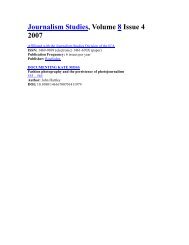GrowinG Future innovators - ARC Centre of Excellence for Creative ...
GrowinG Future innovators - ARC Centre of Excellence for Creative ...
GrowinG Future innovators - ARC Centre of Excellence for Creative ...
Create successful ePaper yourself
Turn your PDF publications into a flip-book with our unique Google optimized e-Paper software.
60<br />
188 Leadbeater (2009a)<br />
189 Xanthoudaki et al. (2003:8)<br />
190 Pringle (2010:2)<br />
191 Pringle (2010:6)<br />
192 Tate (2009)<br />
#5<br />
PARTNERSHIPS<br />
Growing future Innovators: a scoping study<br />
Contemporary art institutions<br />
can broker and build partners and<br />
relationships <strong>for</strong> supporting innovation<br />
that are long-term, reciprocal and<br />
personalized…<br />
by considering the teacher-student<br />
relationship but also looking beyond it<br />
to other partners in learning, such as<br />
artists, peers, parents and families, as<br />
well as business or community groups.<br />
The momentum <strong>for</strong> building partnerships<br />
between cultural and educational<br />
institutions is growing, and healthy<br />
relationships are characterised by what<br />
Leadbeater refers to as “the art <strong>of</strong> working<br />
with,” 188 (as opposed to the service<br />
model <strong>of</strong> <strong>for</strong>), allowing <strong>for</strong> open, sharing,<br />
democratic and participatory modes <strong>of</strong><br />
engagement. Xanthoudaki et al. observe that:<br />
as far as school education is concerned,<br />
museum visits are seen no longer as<br />
an end-<strong>of</strong> term treat or as ‘unfocused’<br />
outings, but as the ground <strong>for</strong> developing<br />
creative and lasting partnerships<br />
betweens museums and galleries and<br />
educational institutions. 189<br />
For over six years the <strong>Creative</strong> Partnerships<br />
scheme in the UK has provided government<br />
funding that has enabled hundreds <strong>of</strong><br />
experimental collaborations between artists,<br />
art institutions, teachers and young people. In<br />
this context, universities have been working<br />
with these partners, helping to facilitate and<br />
report on learning outcomes. These stories <strong>of</strong><br />
collaboration and co-production have been<br />
published in the Enquire research project<br />
and are indicative <strong>of</strong> widening networks<br />
and learning support within the arts and<br />
education sector.<br />
A growing area <strong>of</strong> programming within<br />
contemporary art organisations is ‘family<br />
learning’, an intergenerational, experiential<br />
and playful style <strong>of</strong> co-learning involving<br />
young people and their parents, carers<br />
and relatives. While these programs are still<br />
largely under-researched in terms <strong>of</strong> their<br />
impact, one <strong>of</strong> the rationales operating within<br />
them is that “provision conceived jointly<br />
<strong>for</strong> adults and children can lead to enduring<br />
creative and critical enrichment <strong>for</strong> both.” 190<br />
Outcomes, <strong>for</strong> example, might be improved<br />
literacy or numeracy skills, yet, as Pringle<br />
stresses, the more important opportunity<br />
being <strong>of</strong>fered to families is healthier attitudes<br />
towards learning via “an open, varied, nonthreatening,<br />
experimental, challenging,<br />
playful, enjoyable experience with ideas and<br />
objects.” 191<br />
Rein<strong>for</strong>cing the impact <strong>of</strong> parental<br />
involvement on student achievement that<br />
is discussed in Section 2, Sally Tallant from<br />
Serpentine Gallery suggests that one <strong>of</strong><br />
the reasons institutions establish family<br />
learning programs is because “one <strong>of</strong> the<br />
big barriers <strong>for</strong> children is their parents, who<br />
are intimidated and don’t know the kind<br />
<strong>of</strong> questions to ask. And if they can learn<br />
alongside their children then it’s much easier<br />
<strong>for</strong> them.” This is a motivating factor in why<br />
Serpentine Gallery invites whole families to<br />
engage with artists and their work. Recently,<br />
<strong>for</strong> example, workshops were staged with<br />
Abäke Design Collective and Yan-Ki Lee based<br />
on imagining the family <strong>of</strong> the future. Families<br />
could also ‘drop in’ on artists-in-residence<br />
Polly Brannan and Imogen Luddy to create<br />
new artworks and discuss their ‘future self’.<br />
The value <strong>of</strong> this kind <strong>of</strong> involvement, says<br />
Kate Ryan, Curator Children’s Art <strong>Centre</strong>,<br />
Queensland Art Gallery, is that:<br />
Parents can also see that [the arts are] a<br />
valid <strong>for</strong>m <strong>of</strong> existence in the community.<br />
It’s real work. There are outcomes<br />
which bring enjoyment and pleasure to<br />
people’s lives.<br />
Peer-to-peer styles <strong>of</strong> learning can also be<br />
enabled through the various programs <strong>of</strong><br />
contemporary art institutions that recognize<br />
the agency and affect <strong>of</strong> these relationships.<br />
In addition to the peer-led project groups<br />
identified earlier, another model relying<br />
more on the involvement and coordination<br />
<strong>of</strong> schools is the Tate Modern’s Turbine<br />
Generation project. 192 Sponsored by Unilever,<br />
this online education initiative enables crosscultural<br />
exchange and collaborative learning<br />
between students, and by 2012 is expected to<br />
include classrooms from over thirty countries.<br />
Each year the projects take their theme from<br />
the artist who is commissioned to build a work<br />
<strong>for</strong> the Tate Modern’s architecturally dramatic<br />
Turbine Hall. Anna Cutler says:




![Plebiscite (Riegert chapter) revised FINAL [Feb 14].pdf](https://img.yumpu.com/8710373/1/190x245/plebiscite-riegert-chapter-revised-final-feb-14pdf.jpg?quality=85)